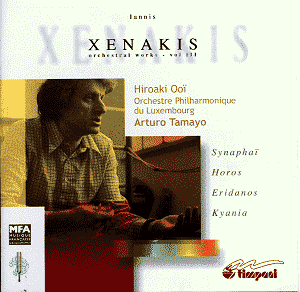The works recorded
here span thirty years of Xenakis’s
composing career. Undoubtedly they share
many characteristics though they also
clearly illustrate his progress over
the years. Common to all these pieces
is, among other qualities, their monolithic
structure made of huge blocks of sounds
tossed against each other. These suggest,
to the present writer at least, inimical,
inhuman, craggy and rugged landscapes
of terrifying power. Xenakis’s orchestral
music often makes its point with densely
scored blocks in remorseless collision
and harshly driven by cyclopean strength.
All four pieces evoke massive, sun-drenched
rocky outcrops, such as may be found,
say, in Northern Africa or in other
desolate places around the world. Synaphaï
(its title means ‘contiguities’ or ‘relationships’)
is no exception, though the basic principle
of the piece, Xenakis’s first concertante
work for piano and orchestra, is to
integrate the incredibly difficult piano
part (the music is spread out onto ten
staves) into the densely structured
fabric. The piano, however, has moments
of its own in the form of two cadenza-like
passages, the second of which is partly
improvised. Also fairly prominent in
this comparatively early work, is the
recurring use of glissandi, a
typical feature in Xenakis’s early music.
This, however, is no traditional concerto
but rather the composer’s own approach
to a traditional musical genre which
he models according to his own idiosyncratic
vision. But, in the final analysis,
the result is not unlike that of the
other pieces recorded here.
Eridanos,
scored for strings and eight brass instruments
(neither woodwinds nor percussion),
is a concise, massive monolith of considerable
power and energy. The title refers to
the name of a river once running through
Athens and of a constellation of the
Southern Hemisphere, meaning quarrelsome,
which at least gives some idea of the
violent nature of much of the music.
The composer also mentions that the
idea was that of a DNA cell consisting
of four elements: H(ydrogen), O(xygen),
C(arbon) and P(hosphorus) which are
represented by groups of fixed, but
mutable intervals. H and O are played
by the strings, C and P by the brass.
Horos
(the Greek word meaning marker
or reference point as in ‘orology’),
composed in 1986, is fully representative
of Xenakis’s late orchestral music.
Now, compact and massive layers of sounds
move in closer homophony and are supported
by huge ostinatos. Another new
feature appearing here – and in marked
contrast with many earlier works – is
the conspicuous absence or, at least,
rarity of glissandos.
Kyania
(same etymological root as cyanide),
scored for large orchestra with an important
piano part but without percussion, is
by far the most substantial work here,
i.e. in terms of overall duration and
also of structural complexity. It is
– again – a massive structure, often
densely, thickly scored and consistently
based on big clusters. The music moves
on in a fairly moderate tempo but with
considerable strength, again suggesting
implacably striding giants. The music
eventually fades away mysteriously on
a last long-held cluster.
Xenakis’s music has
at times been blamed for being rather
single-minded, but these four works
from different periods of the composer’s
creative life clearly illustrate the
variety of his approach over the years.
As such, the present release is, to
my mind, the best possible introduction
to Xenakis’s highly personal sound world.
Performances cannot be bettered (Arturo
Tamayo and the Luxembourg orchestra
deserve all praise for their commitment
and physical endurance in these taxing
works) and the recording is simply stunning.
Hard stuff, no doubt, but gripping all
the same.
Hubert Culot
Simply stunning. Hard
stuff but gripping … the best possible
introduction to Xenakis … see Full Review



